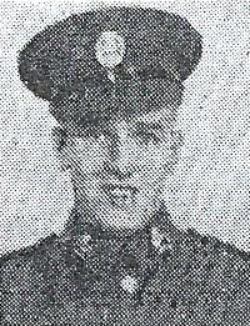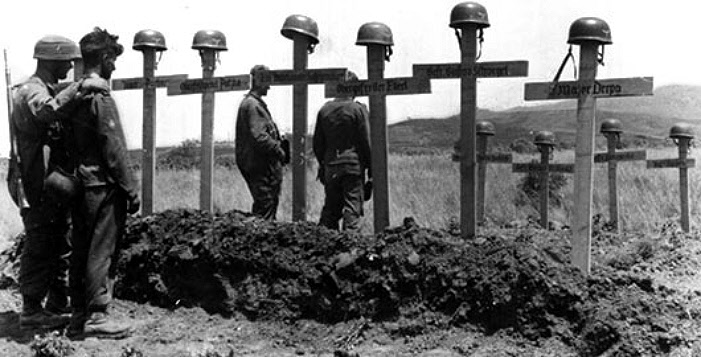
John Clapham was born in Batley Carr in summer 1915, the second of six sons and one daughter born to John Clapham and Margaret Coldwell who married at St. John’s Church, Cleckheaton on the 21st December 1912. At the time of his marriage John senior was 18 years of age and a miner living at 16, Thomas Street, Batley Carr. He was one of six children born to his parents, but tragically four had died before April 1911. Margaret Coldwell, born in Ledsham, near Castleford, was herself one of five daughters and one son born to her parents. In 1911 she was a spinner and living with her family at Vine Street, Cleckheaton, but at the time of her marriage, aged 20 years, she had moved to 10, Westgate Square, Cleckheaton. John Clapham senior died in early 1929, aged 34 years, leaving his widow with seven children under the age of 16 years.
John Clapham junior joined the 2nd Battalion, York and Lancaster Regiment circa 1936 as a regular soldier. At the outbreak of the Second World War, the 2nd Battalion, York and Lancaster Regiment was based in Khartoum in the Sudan on garrison duties. He married Sarah Wilby of Ossett in late December 1937 and they settled at 4, Land’s Fold, Town End. The couple appear not to have had children. Sarah is likely to have been born in 1918, the daughter of Francis Clifford Wilby of South Ossett and Polly Humphries, who married in early 1915.
In July 1940, the York and Lancasters were moved to Egypt, and then to Palestine, where they became part of the 14th Infantry Brigade. The battalion was again part of the 6th Infantry Division. In May 1940 the 14th Infantry Brigade moved to Cairo and was then broken up. The 2nd Battalion, York and Lancasters went to Alexandria, Egypt. The battalion, now on loan to the Royal Navy was moved to Crete in the cruiser HMS Ajax, arriving at Suda Bay, Crete on the 2nd November 1940. Their arrival was met by an attack from the Italian Air Force. The 14th Infantry Brigade was reformed around the 2nd Battalion, Yorks and Lancs and the 2nd Battalion, Black Watch. The reformed brigade spent its time building defences on the island, but these were limited. Little happened on Crete until April 1941 when the Allied forces in Greece were evacuated.
With the surrender of Greece in 1941 Crete was thrust into the war. The 2nd Battalion, Yorks and Lancs along with the 2nd Battalion, Black Watch and 2nd Battalion, The Leicestershire Regiment were tasked with the defence of Heraklion airfield. From the middle of May 1941, air attacks against Heraklion increased to four or five a day, but the RAF 33 Squadron had been withdrawn from the island on the 19th May, so there was no air defence other than AA batteries. On the 20th May 1941, troop carriers dropped German paratroopers at Maleme airfield on the west of the island.
Warning reached Heraklion as their own share of German Ju52 troop transports were spotted arriving at a height of about 400 feet, four abreast, in long columns that stretched out of sight. This was the largest of the German parachute formations made up of the 1st Fallschirmjager Regiment, 2nd Battalion from the 2nd Fallschirmjager Regiment and an AA Machine Gun Battalion under the command of Col. Bruno Brauer.
The three battalions of the 14th Brigade managed to kill or wound nearly all the German parachute troops that were landed at Heraklion on in this first wave, apart from a small pocket, the brigade had inflicted massive casualties on the enemy paratroopers.
From the “War Diary” of the 2nd Battalion, York and Lancaster Regiment:
“In a matter of seconds the air was full of parachutes slowly descending to the ground. The moment the Battalion had waited for had come. Intense small-arms fire caused very heavy casualties among the enemy. Of those who escaped death in the air, the majority were killed on the ground, before they had time to get clear of their harness, by small parties of men rushing from their slit trenches with bayonets and bombs. The tanks and carriers also came out of their hiding-places and massacred all those who landed in the open.
On the Battalion front outside the perimeter opposite “B” Company, one large group of enemy landed in an area occupied by some Greek troops. “B” Company promptly attacked and spent a couple of hours in rather confused fighting in some very enclosed country. They killed a number of the enemy and then left the Greeks to carry out the final mopping-up. Meanwhile, well inside the perimeter another body of enemy had collected in a small village. “C” Company, which was in reserve, put in an immediate counter-attack and dealt with them well and truly before they had time to get properly organized. Some eighty of the enemy were killed for the loss of about five casualties. The rest of the Battalion was not so heavily involved but dealt with everything that fell in its area, even the Quartermaster, Lieutenant Armstrong, taking part and for the expenditure of one round, accounting for the only paratrooper who had the temerity to try and invade his store.
The enemy fared no better at the hands of the other units of the garrison. Of about 1,000 enemy troops who had come down inside the perimeter, over 900 of them had been buried by noon the next day. Small parties and odd individuals of course escaped, but these were mopped up during the next few days. Quite a large force, however, had fallen clear of the perimeter and parties of them were heard calling to each other after dark; they made no attempt to attack, being possibly too shaken by what had happened to their comrades. Thus the day ended in complete victory for the Heraklion garrison and the total failure of the Germans to achieve their object of capturing the aerodrome by direct airborne attack.”
For their invasion of Crete, the German forces undertook the largest parachute operation of the war thus far, and over 9,500 airborne paratroops landed, with around 7,000 killed.

After this attempt the Germans did not try to land any more paratroopers at Heraklion, and instead they built up their forces outside the perimeter. The German forces now had control of the airfield at Maleme and this gave them the advantage they needed after their heavy losses earlier. They landed four more companies of troops in the vicinity of Heraklion which successfully linked up with the survivors of the first landings and launched counterattacks on the British positions. Before the Germans were able to complete the encirclement of Heraklion a company from the 1st Battalion, Argyll and Sutherland Highlanders joined the defence from Tymbaki on the south coast. The Germans were continually probing against the defences and the following is the last serious fighting in which the battalion took part before their evacuation from the island.
The fighting at this time was extremely fierce but the Yorks and Lancs held their positions. By the 28th May 1941, the position on the island as a whole had been lost and General Freyberg ordered the evacuation. When the men of the 14th Brigade heard of the evacuation they were astonished. To them, the whole battle of the last ten days had seemed to have been eminently successful.
Unfortunately, this was too late for Private John Clapham and he was killed in the Battle of Crete. The battle has now become one of the most studied battles in the early part of the war.
The “Ossett Observer” had this report about the loss of Private Clapham:1
“Private John Clapham, whose home is at 4, Land’s Fold, Town End, Ossett, has been reported missing since June 2nd, a letter from the War Office to this effect being received on Tuesday by his his wife. Private Clapham who joined the York and Lancaster Regiment 4½ years ago is believed to have been serving in Crete. He has been stationed abroad for the past 2½ years, including India, The Sudan and Palestine. Before joining the Army, he was employed as a miner at Thornhill Edge, and was previously a lorry driver. A native of Batley Carr, he married Miss Sarah Wilby, of Town End, 3½ years ago. She was for some years an attendant at the Palladium Cinema. Private Clapham was a keen cyclist and swimmer.”
Private John Clapham died age 25 years between 28th and 29th May 1941 and is remembered on Face 7 of the Athens Memorial. The Athens Memorial stands within Phaleron War Cemetery and commemorates nearly 3,000 members of the land forces of the Commonwealth who lost their lives during the campaigns in Greece and Crete in 1941 and 1944-1945, in the Dodecanese Islands in 1943-1945 and in Yugoslavia in 1943-1945, and who have no known grave.2
The site of what is now Phaleron War Cemetery was chosen originally by the 4th Division as a burial ground for Commonwealth casualties of the Greek Civil War (December 1944-February 1945). Subsequently, the military authorities, in conjunction with the Greek Government and the Army Graves Service, decided that it would be the most suitable site for a Second World War cemetery for the whole mainland of Greece. The 23rd and 24th Graves Registration Units and the 21st and 22nd Australian War Graves Units worked together to bring in graves of the 1941 campaign from the battlefields, temporary military cemeteries and from various civil cemeteries.
There are now 2,028 Commonwealth servicemen of the Second World War buried or commemorated in this cemetery. 596 of the burials are unidentified. Special memorials commemorate casualties known to have been interred in certain groups of graves in the cemetery, but whose individual graves cannot be precisely located within these groups. Other special memorials commemorate casualties re-buried in the cemetery from original graves which, owing to the destruction of local records, could not be identified.

Above: German paratroopers counting the cost of their invasion of Crete in May 1941. Many Cretan civilians joined in with the Allied troops and shot at the German paratroopers as they descended on the island. Cretan civilians were also picking off paratroopers or attacking them with knives, axes and scythes. Over 1,135 civilians were executed by the Germans between June and September 1941 and numerous villages were destroyed.
References:
1. “Ossett Observer”, 12th July 1941.